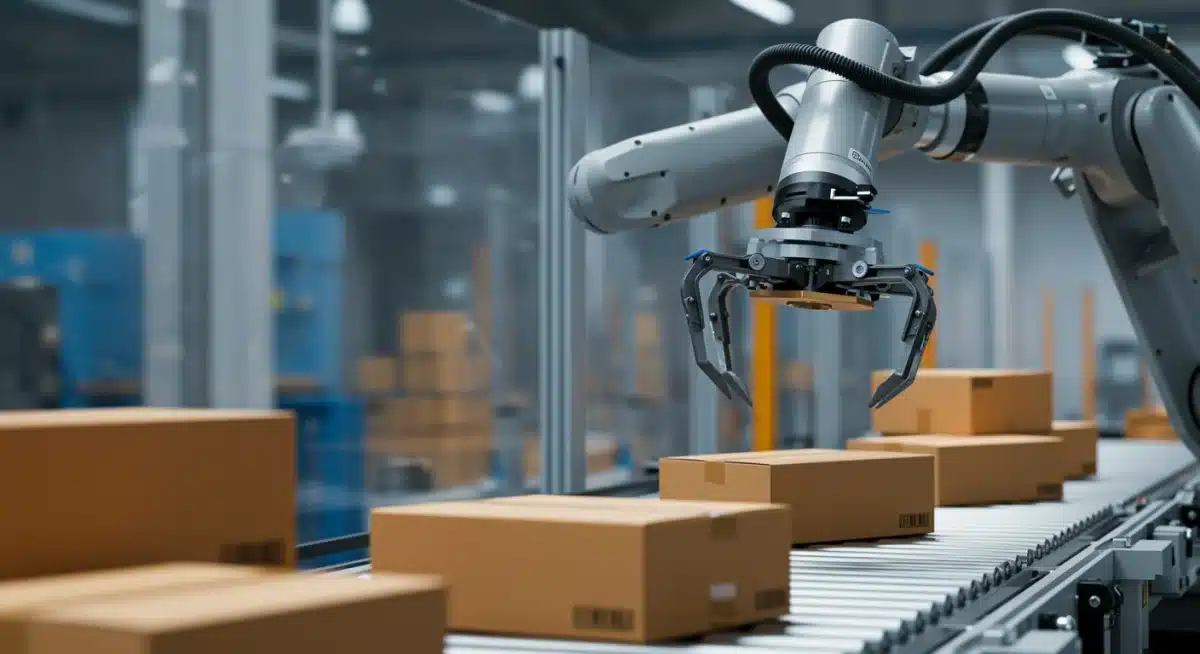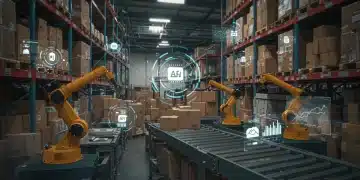Autonomous Robotics in Logistics: US Supply Chains Cut Costs by 18%

Autonomous robotics in logistics is now enabling US supply chains to achieve an average 18% reduction in operational costs, profoundly impacting efficiency and operational models.
Recent reports indicate a significant shift in the US logistics sector as companies increasingly adopt Autonomous Robotics in Logistics: Reducing Operational Costs by 18% for US Supply Chains. This technological integration is not merely an upgrade; it represents a fundamental overhaul of how goods are handled, stored, and transported, leading to substantial cost savings and enhanced efficiency across the board. What does this mean for the future of American commerce?
The Rise of Autonomous Mobile Robots (AMRs) in Warehousing
Autonomous Mobile Robots (AMRs) are rapidly becoming a cornerstone of modern warehousing, moving materials and products without human intervention. These intelligent machines navigate dynamic environments using advanced sensors and AI, optimizing routes and avoiding obstacles. Their deployment is directly contributing to the reported 18% reduction in operational costs by minimizing labor expenses and maximizing throughput.
The flexibility of AMRs allows them to be scaled up or down based on operational needs, making them a versatile solution for varying demand cycles. This adaptability is critical for supply chains facing unpredictable market fluctuations and labor shortages.
Enhanced Efficiency and Throughput
One of the primary drivers behind AMR adoption is their ability to dramatically increase operational efficiency. Unlike traditional automated guided vehicles (AGVs), AMRs do not require fixed paths, allowing for greater freedom and optimization in complex warehouse layouts.
- Faster Order Fulfillment: AMRs can pick and transport orders at speeds far exceeding human capabilities, reducing processing times.
- Optimized Storage: By intelligently navigating, AMRs can utilize warehouse space more effectively, increasing storage density.
- Reduced Errors: Automation minimizes human error in picking and sorting processes, leading to fewer mis-shipments and returns.
Impact on Labor and Workforce Dynamics
The introduction of autonomous robotics in logistics is reshaping the traditional workforce. While some fear job displacement, the reality often involves a shift in roles, with human workers transitioning to supervisory, maintenance, or data analysis positions. This evolution requires new skill sets and training programs.
Companies are investing in upskilling their existing workforce to manage and interact with robotic systems. This strategic approach ensures that human expertise remains central to operations, even as machines take over repetitive and physically demanding tasks.
Creating New Job Opportunities
The robotics industry itself is generating new employment opportunities in areas such as robot design, manufacturing, programming, and maintenance. This creates a symbiotic relationship where technological advancement fuels economic growth and diversification.
- Robotics Technicians: Demand for skilled individuals to repair and maintain robotic fleets is increasing.
- AI Specialists: Experts in artificial intelligence are needed to optimize robot navigation and decision-making algorithms.
- Data Analysts: Professionals who can interpret the vast amounts of data generated by robotic systems are crucial for continuous improvement.
Cost Reduction Strategies Through Automation
The 18% operational cost reduction is a direct result of several key automation strategies. These include minimizing labor costs, optimizing energy consumption, reducing product damage, and improving inventory accuracy. Each factor contributes significantly to the overall financial benefits.
By automating tasks that are prone to human error, companies also reduce the costs associated with rework, returns, and customer service issues. The consistency and precision of robotic systems lead to a more streamlined and less wasteful operation.
Key Areas of Savings
Deployment of autonomous systems offers tangible financial advantages across various operational facets. These savings are not just theoretical but are being realized by leading logistics providers.
- Reduced Labor Expenses: Automation of repetitive tasks lowers the need for extensive manual labor, especially in areas with high turnover.
- Energy Efficiency: Modern robots are designed to be energy-efficient, often operating on rechargeable batteries and optimizing movement.
- Inventory Accuracy: Automated tracking and handling significantly reduce discrepancies, leading to better stock management and less waste.
Enhancing Supply Chain Resilience and Agility
Beyond cost savings, autonomous robotics significantly enhance the resilience and agility of US supply chains. The ability to operate 24/7, coupled with rapid deployment capabilities, allows logistics operations to respond quickly to market demands, seasonal peaks, and unexpected disruptions. This newfound flexibility is a critical competitive advantage.
In an era of increasing supply chain volatility, the robustness offered by automation ensures continuity and minimizes downtime. Companies can maintain consistent service levels even during labor shortages or other unforeseen challenges.
Adapting to Market Fluctuations
The ability to scale operations quickly is paramount. Autonomous systems provide this elasticity, ensuring that capacity can be adjusted without extensive recruitment or training.
- Scalable Operations: Easily add or remove robots to match fluctuating demand without significant infrastructure changes.
- 24/7 Operation: Robots can work continuously, maximizing asset utilization and throughput.
- Reduced Dependency: Less reliance on human labor in critical areas reduces vulnerability to labor strikes or public health crises.
Challenges and Future Outlook for Robotics Integration
While the benefits are clear, the integration of autonomous robotics is not without its challenges. Initial investment costs can be substantial, requiring careful financial planning and a clear return on investment (ROI) strategy. Furthermore, ensuring interoperability between different robotic systems and existing IT infrastructure presents a complex technical hurdle.
Cybersecurity is another growing concern, as automated systems become increasingly connected. Protecting these networks from potential threats is paramount to maintaining operational integrity and data security.

Overcoming Implementation Hurdles
Addressing these challenges requires a multi-faceted approach, involving strategic partnerships, robust cybersecurity measures, and continuous technological innovation.
- High Initial Investment: Companies must conduct thorough cost-benefit analyses to justify the upfront capital expenditure.
- Integration Complexity: Ensuring seamless communication and operation between diverse robotic platforms and legacy systems is crucial.
- Cybersecurity Risks: Protecting automated networks from cyber threats is essential to prevent operational disruptions and data breaches.
Case Studies: Real-World Success in US Supply Chains
Numerous US companies are already demonstrating the tangible benefits of integrating autonomous robotics. For instance, a major e-commerce retailer recently reported a 20% increase in warehouse efficiency and a 15% reduction in labor costs after deploying a fleet of AMRs in its fulfillment centers. Another large third-party logistics (3PL) provider saw an 18% cut in operational expenses within 18 months of implementing robotic sorting and picking systems.
These success stories highlight that the 18% cost reduction is not an isolated incident but a consistent outcome for early adopters. The competitive edge gained by these pioneers is prompting others to accelerate their own automation initiatives, signaling a broader industry trend.
Examples of Industry Leaders
Companies across various sectors are leveraging autonomous robotics to redefine their operational benchmarks and enhance their market position. The proven track record of these implementations serves as a powerful testament to the technology’s potential.
- Retail Giants: Utilizing AMRs for inventory management and order picking, significantly speeding up delivery times.
- Manufacturing Facilities: Employing robotic arms for assembly and quality control, reducing production costs and defects.
- Freight Forwarders: Deploying autonomous vehicles in controlled environments for inter-warehouse transport, optimizing internal logistics.
| Key Benefit | Description |
|---|---|
| Operational Cost Reduction | Achieving an average of 18% savings across US supply chains through automation. |
| Enhanced Efficiency | Robots increase throughput, optimize storage, and reduce errors in logistics operations. |
| Workforce Transformation | Shifting human roles to supervision and maintenance, creating new tech-focused jobs. |
| Supply Chain Resilience | Automation allows 24/7 operation and rapid scalability, improving adaptability to disruptions. |
Frequently Asked Questions About Autonomous Robotics in Logistics
The primary benefits include an average 18% reduction in operational costs, significantly enhanced efficiency, improved inventory accuracy, and increased supply chain resilience, allowing for 24/7 operations and faster order fulfillment.
AMRs reduce costs by automating repetitive tasks, minimizing labor expenses, optimizing energy usage through efficient navigation, and decreasing product damage and errors, which in turn reduces rework and returns.
While some roles may change, the trend indicates a shift in labor, with new jobs emerging in robot maintenance, programming, and data analysis. Companies are also investing in upskilling their existing workforce.
Key challenges include substantial initial investment costs, complex integration with existing IT infrastructure, and the necessity for robust cybersecurity measures to protect connected autonomous systems from threats.
Automation enables 24/7 operation and rapid scalability, allowing supply chains to quickly adapt to fluctuating market demands, seasonal peaks, and unexpected disruptions like labor shortages, ensuring continuous service.
Looking Ahead
The current trajectory of Autonomous Robotics in Logistics: Reducing Operational Costs by 18% for US Supply Chains suggests a future where automation is not just an advantage but a necessity. As companies continue to navigate global economic shifts and consumer demands for faster, cheaper delivery, the adoption of robotic solutions will only accelerate. Expect to see continued innovation in robot capabilities, further integration with AI and machine learning, and a stronger emphasis on collaborative human-robot workflows, all aimed at driving efficiency and competitive advantage.





